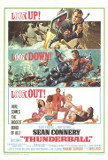Thunderball (United Kingdom, 1965)

By the time Thunderball, the fourth in the "official" James Bond film canon, was released, the "Bond Formula" had already been perfected. It goes something like this: take the suave 007 (always impeccably dressed and ready with a witty one-liner) and add several beautiful, scantily-clad women, at least one exotic locale, a few neat gadgets, multiple polished action sequences, a megalomaniac villain, and a musical score by the inimitable John Barry. These elements, taken together, made Bond a huge success in the 1960s and have kept him riding a crest of financial profitability for more than three decades.
Thunderball is from the team that brought all the early Bond adventures to the screen: lead actor Connery (as 007), director Terence Young (who also helmed Dr. No and From Russia with Love), longtime Bond screenwriter Richard Maibaum, cinematographer Ted Moore, title sequence designer Maurice Binder, and composer John Barry. Thunderball proved to be the most popular Bond of all, topping UK and US box offices in late 1965 and early 1966. The film was so well-received, in fact, that it was remade some 18 years later as Never Say Never Again.
As Thunderball opens, SPECTRE is again on the move. This time, the mission -- to blackmail the United States and Great Britain -- is headed by Number Two, Emilio Largo (Adolfo Celi). The plot he has masterminded involves stealing two nuclear weapons, then threatening to blow up a major city if the two countries don't pay the ransom. After the threat has been issued, M (Bernard Lee) calls in the "00" agents and assigns them to tasks around the world with the goal of finding and stopping Largo. 007 draws Nassau, where he encounters old friend Felix Leiter (played this time by Rik Van Nutter), Largo's lovely mistress, Domino (Claudine Auger), and a host of deadly adversaries.
At two and one-quarter hours, Thunderball runs too long. Certain sequences could have been trimmed, especially the climactic underwater battle, which seems to take forever. The villain of the piece is a little weak, coming in the wake of such memorable adversaries as Dr. No and Goldfinger. While Adolfo Celi is suitably menacing, he plays Largo like a high-placed thug. There is some compensation for the deficiencies of the lead villain, however. It comes in the person of femme fatale Fiona (Luciana Paluzzi), whose sophisticated, black widow-like personality makes her more dangerous than any male SPECTRE agent.
Of all his Bond performances, Sean Connery seems the most comfortable here (not that he was ever uncomfortable). With three movies behind him and two more yet to come, Connery was in the midst of a career-making, successful run. His screen version of the superspy may not be what Ian Fleming envisioned when he first put pen to paper, but, by the release of Thunderball, the actor had left his indelible imprint on the role -- a characterization that none of the performers following him has been able to equal. The 007 of the books is different from the 007 of the movies, and Sean Connery is James Bond for the film-going audience (with apologies to George Lazenby, Roger Moore, Timothy Dalton, and Pierce Brosnan).
The underwater sequences, which are choreographed and directed with great skill, are Thunderball's standout feature. Connery is more often in a bathing suit than a tuxedo here. A fair amount of time is spent beneath the ocean's surface, and, down in Neptune's realm, the photography (by Lamar Boren) is clear and the action sequences are invigorating (when they don't seem to last forever, that is). Thunderball is classic 007 -- not the best picture in the long-running series, to be sure, but a more-than-worthwhile diversion for the action-loving escapist in us all.
Thunderball (United Kingdom, 1965)
Cast: Sean Connery, Claudine Auger, Adolfo Celi, Luciana Paluzzi, Rik Van Nutter, Bernard Lee, Martine Beswick, Desmond Llewelyn, Lois Maxwell
Screenplay: Richard Maibaum and John Hopkins based on the original story by Kevin McClory, Jack Wittingham, and Ian Fleming
Cinematography: Ted Moore and Lamar Boren (underwater)
Music: John Barry
U.S. Distributor: United Artists
U.S. Release Date: -
MPAA Rating: "PG" (Violence, Sexual Situations)
Genre: ACTION/THRILLER
Subtitles: none
Theatrical Aspect Ratio: 2.35:1
- (There are no more better movies of Claudine Auger)
- (There are no more worst movies of Claudine Auger)
- (There are no more better movies of Adolfo Celi)
- (There are no more worst movies of Adolfo Celi)
Comments